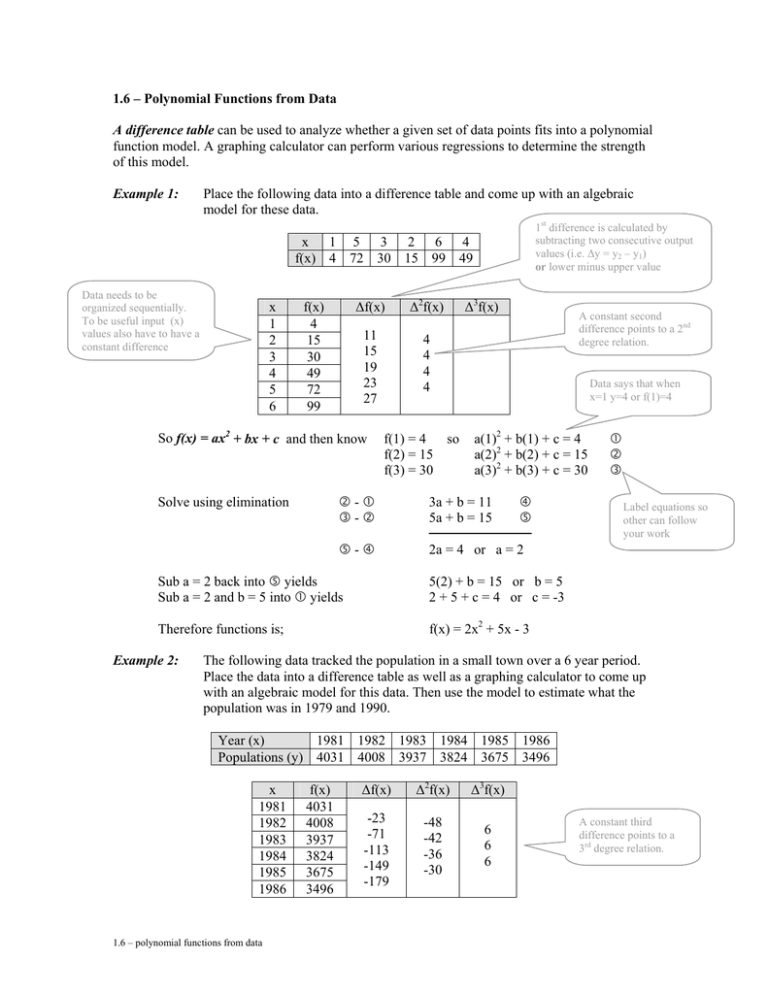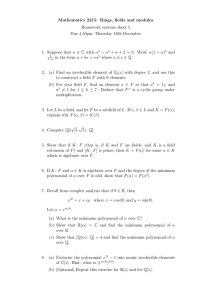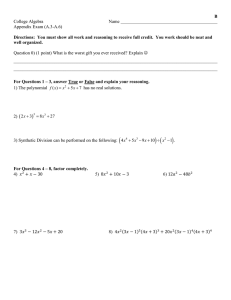1.6 – Polynomial Functions from Data of this model.
advertisement

1.6 – Polynomial Functions from Data A difference table can be used to analyze whether a given set of data points fits into a polynomial function model. A graphing calculator can perform various regressions to determine the strength of this model. Example 1: Place the following data into a difference table and come up with an algebraic model for these data. 1st difference is calculated by subtracting two consecutive output values (i.e. Δy = y2 – y1) or lower minus upper value x 1 5 3 2 6 4 f(x) 4 72 30 15 99 49 Data needs to be organized sequentially. To be useful input (x) values also have to have a constant difference x 1 2 3 4 5 6 f(x) 4 15 30 49 72 99 Δf(x) Δ2f(x) 11 15 19 23 27 4 4 4 4 So f(x) = ax2 + bx + c and then know Solve using elimination f(1) = 4 f(2) = 15 f(3) = 30 Δ3f(x) A constant second difference points to a 2nd degree relation. Data says that when x=1 y=4 or f(1)=4 so a(1)2 + b(1) + c = 4 a(2)2 + b(2) + c = 15 a(3)2 + b(3) + c = 30 d-c e-d 3a + b = 11 5a + b = 15 f g g-f 2a = 4 or a = 2 Sub a = 2 back into g yields Sub a = 2 and b = 5 into c yields 5(2) + b = 15 or b = 5 2 + 5 + c = 4 or c = -3 Therefore functions is; f(x) = 2x2 + 5x - 3 Example 2: c d e Label equations so other can follow your work The following data tracked the population in a small town over a 6 year period. Place the data into a difference table as well as a graphing calculator to come up with an algebraic model for this data. Then use the model to estimate what the population was in 1979 and 1990. Year (x) 1981 1982 1983 1984 1985 1986 Populations (y) 4031 4008 3937 3824 3675 3496 x 1981 1982 1983 1984 1985 1986 1.6 – polynomial functions from data f(x) 4031 4008 3937 3824 3675 3496 Δf(x) Δ2f(x) Δ3f(x) -23 -71 -113 -149 -179 -48 -42 -36 -30 6 6 6 A constant third difference points to a 3rd degree relation. Difference table show a 3rd degree relation which is confirmed by a regression value of 1 on the graphing calculator So we know it will have the general form: p(y) = ay3 + by2 + cy + d The graphing calculator gives the following: a=1 b = -5970 c = 11880060 d = -7880118800 R value indicates a strong postive correlation So our equation is: And so 1979 R2 = 1 Large values would make algebraic calculation more difficult. One could adjust years to zero (i.e. 1981Æ0 and 1982Æ 1, etc) p(y) = y3 – 5970y2 + 11880060y - 7880118800 p(1979) = (1979)3 – 5970(1979)2 + 11880060(1979) - 7880118800 = 3909 p(1990) = 2600 Population as a function of year 1.6 – Polynomial Functions from Data Practice Questions 1. Determine, by algebraic methods, a polynomial function that models the data below; a) b) c) d) (1,0), (2,-2), (3,-2), (4,0), (5,4), (6,10) (1,-1), (2,2), (3,5), (4,8), (5,11), (6,14) (1,-4), (2,0), (3,30), (4,98), (5,216), (6,396) (1,-9), (2,-10), (3,-7), (4,0), (5,11), (6,26) 2. Use a graphing calculator to determine the best polynomial function that models the data. Note that the data does not necessarily have a perfect (regression value of 1) fit to one polynomial model a) (1,1), (2,-3), (3, 5), (4,37), (5,105), (6,221) b) (0,4), (1,16), (2,30), (3,60), (4,120), (5,250) c) (1,-9), (2,-31), (3,-31), (4,51), (5,299), (6,821) Answers 1. a) f(x)= x2 - 5x + 4 b) g(x) = 3x - 4 c) h(x) = 2x3 + x2 – 13x + 6 d) m(x) = 2x2 – 7x – 4 2. a) y=2x3-6x2+5 R=1 b) y=3.5x3-12.7x2+24.3x+3.2 R=0.99 c) y=x4-14x2+5x-1 R=1 1.6 – polynomial functions from data







